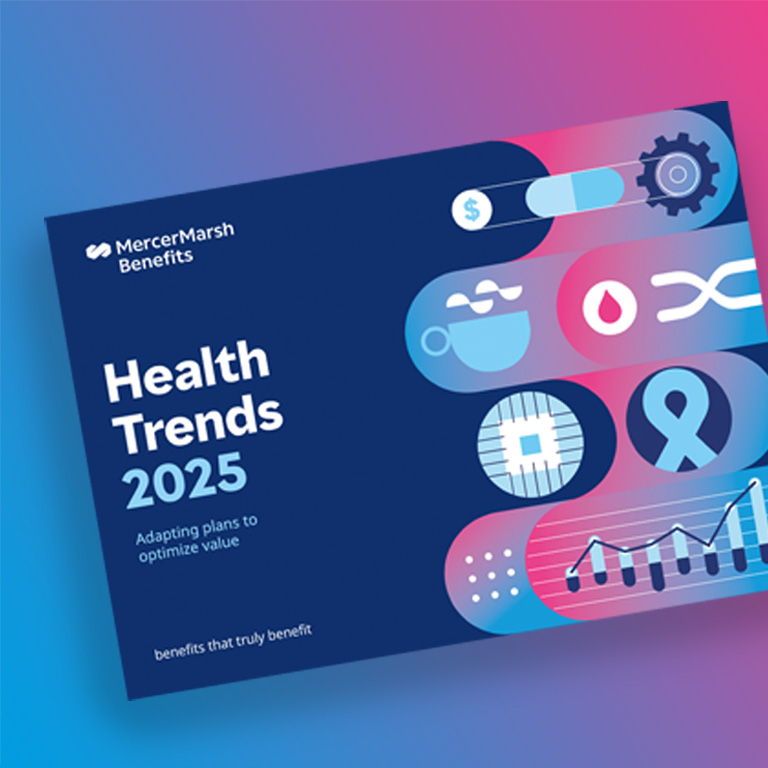
By Philip Broomhead ,
Mercer Marsh Benefits Placement Leader, New Zealand
29/03/2023 · 4 minute read
Health insurance premium increases could rise to double digits in 2023 and beyond. This is due to cost pressures brought about by medical inflation, which is attributed to the rising costs associated with medical procedures, medication advancements, and an increasing number of medical claims.
Let’s take a closer look at some of the factors driving medical inflation.
Medical advances have led to better treatments, but at the same time more expensive treatments.
Robotic surgery is now replacing some manual procedures with the added advantage of allowing patients to recover more quickly, however, the technology is expensive to purchase and maintain.
Keyhole surgery has lower risk than open heart surgery, and results in less scarring and faster recovery, but it too comes at an increased cost.
New medications, including advancements in chemotherapy, are being regularly introduced. These can be more effective and have fewer side effects than older medications. However, even though the costs associated with these may diminish over time, as new treatments become mainstream and medications are produced in larger quantities, the initial costs to produce these medications in smaller quantities are quite high due to the advanced techniques and technologies employed.
Public health providers are increasingly promoting preventative approaches in the pursuit of wellbeing. However, with this comes an increased use of medical diagnostics.
This means that health service providers are increasingly requesting additional diagnostics, which in turn can be more sophisticated and expensive. Of course, this can help pinpoint the cause of ill health to treat it and avoid further complications. At the same time, however, additional scans and imaging will add to the overall cost treatment.
As an example, large joint surgery in the past would have included two diagnostic procedures before and after surgery. In modern cases, three are now typically recommended. Doctors now use scans to determine the efficacy of some cancer drugs during a course of treatment, at additional cost. And surgery may now be recommended earlier, increasing costs and the number of surgical claims.
Changes in attitudes also contribute to the increased number and cost of health insurance claims. While in the past people might have tolerated some discomfort or partial loss of capability, today most people expect that their ill health can and will be treated.
With better access to quality information, people are also generally more aware of health conditions, symptoms, and the treatments available, and therefore better placed to make more sophisticated and informed decisions.
Although to a lesser extent, soaring inflation rates in the general economy also affect medical inflation.
Claims are playing catch up after COVID-19
Over the last couple of years claims have been volatile due to COVID-19 disruptions. It now seems they are playing catch-up with larger than normal claims patterns emerging in 2022, which insurers expect to continue into 2023.
Medical insurers globally are seeing similar trends. While COVID-19 resulted in a lower usage of healthcare services, and a subsequent drop in the number of health insurance claims, there is evidence that medical trend rates have returned to pre-pandemic levels.[1]
The following example is taken from the MMB Health Trends, Global insurer report survey, fielded in August 2022.
Generally we expect that rates may increase 10-15% through 2023 and into 2024.Some medical providers contract with medical suppliers on an annual basis with increases linked to a combination of measures.
As contracts renew, suppliers will factor in cost increases as contractually agreed, but increases are likely to be spread over a couple of years, rather than delivered in one full increase. And some insurers are also using previous year’s surpluses to soften increases.
Overall, however, we expect insurers to be seeking increases regardless of whether health insurance premiums are calculated based on the insurer’s own claims experience (experience-rated) or based on a wider pool.
While it may be too late to influence premiums this year, there are some things you can do to help mitigate the effects of increases including:
Mercer Marsh Benefits also has a number of tools available to help clients plan and manage future costs.
Please contact your local Mercer Marsh Benefits adviser if you have further queries or would like to know more about how we can support you.
[1] ‘Medical trend’ is generally defined as the year-over-year cost increase for claims under a medical plan on a per-person basis. The rate growth is due in part to medical inflation, as well as other factors. Link to MMB Health Trends, Global insurer report survey

Article
13/10/2024